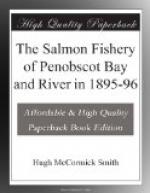Extension of salmon-hatching operations on the Penobscot.
The establishment of branch hatcheries has been suggested in order to utilize the spawning salmon in the region which lies above commercial fishing, and thus increase by artificial means the production of young fish. It is well known that even under the best conditions now prevailing in our streams the eggs of anadromous fishes like the salmon and shad are liable to numerous destructive agencies; that only a small percentage of the eggs laid under natural surroundings ever hatch, and that the young are subject to heavy mortality up to the time when they leave the river and enter the salt water. Probably 5 per cent would be much too large an estimate of the number of salmon eggs which in a state of nature produce fish that reach the ocean. Fish-culture, on the other hand, hatches 95 per cent of the eggs and raises 75 per cent of the fry to the age of yearlings. Of 206,350 Atlantic salmon eggs obtained in 1895 at the government station at Craig Brook, 206,109 were hatched and 151,761 yearling fish were liberated in the fall. The percentage of eggs hatched was thus 99.88 and the percentage of yearlings raised was 78.39. This is sufficient ground for interfering with the salmon even after they have reached their spawning-beds, and justifies the establishment of hatcheries in the headwaters of the Penobscot, provided the supply of fish in any section is large enough to insure a reasonable take of eggs.
No examinations of the upper tributaries of the Penobscot thus far made have disclosed the existence of any stream on which the construction of a branch salmon hatchery is warranted, owing to the few salmon obtainable. The matter deserves further investigation, however, and will receive due consideration at an early date. It is thought that a satisfactory supply of fish may be secured by constructing a dam or rack which will intercept fish in the main stream and lead practically the entire run into one tributary, where they may be retained.
The operation of a branch salmon hatchery in the river above Bangor would of course depend on the successful working of the fishways and the enforcement by the State of the anti-poaching laws.
Planting of quinnat salmon and steelhead trout in Maine streams.
The United States Fish Commission is making the experiment of planting large numbers of non-indigenous salmon in the Penobscot Basin and other Maine waters with a view to test whether the fishes are adapted to those streams. The species with which trials have thus far been made are the quinnat or chinook salmon (Oncorhynchus tschawytscha) and the steelhead trout (Salmo gairdneri). It is intended to plant sufficiently large numbers of yearling fish to fully test the feasibility of the project; and in the event of success two extremely valuable species will have been added to the fishery resources of the Maine streams.




